

设计单位 IN.X屋里门外设计
项目地点 中国北京
建成时间 2020年11月
项目面积 1260平方米
本文文字由设计单位提供。
1981年,四季民福马连道店所在的建筑落成,其位于红莲路与马连道胡同西北相交处,作为纸库的厂房用于存放纸浆和成品纸。原建筑采用无梁楼盖结构——即楼面荷载直接通过有柱帽立柱传至基础,这类结构体系曾被广泛应用于工业建筑中,是典型仓库功能所采用的形态。
In 1981, the original building of Siji Minfu Restaurant (Maliandao) was built at the northwest intersection of Honglian Road and Maliandao Hutong, which served as a warehouse for paper products. It adopts the beamless floor structure is commonly seen in the industrial age—that is, the floor load is directly transmitted to the foundation through the columns. This type of structural system has been widely used in industrial buildings, especially in the form of warehouses.
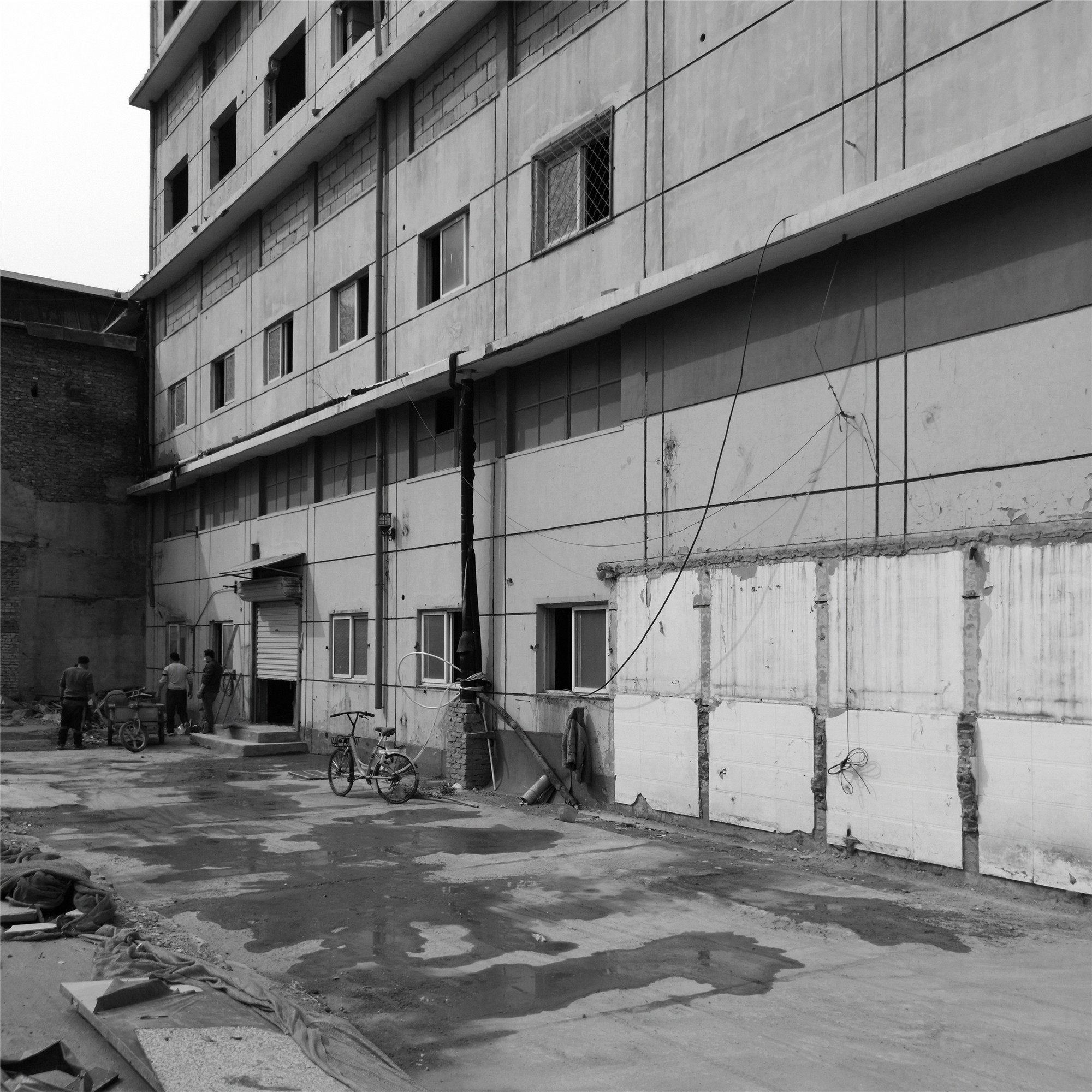
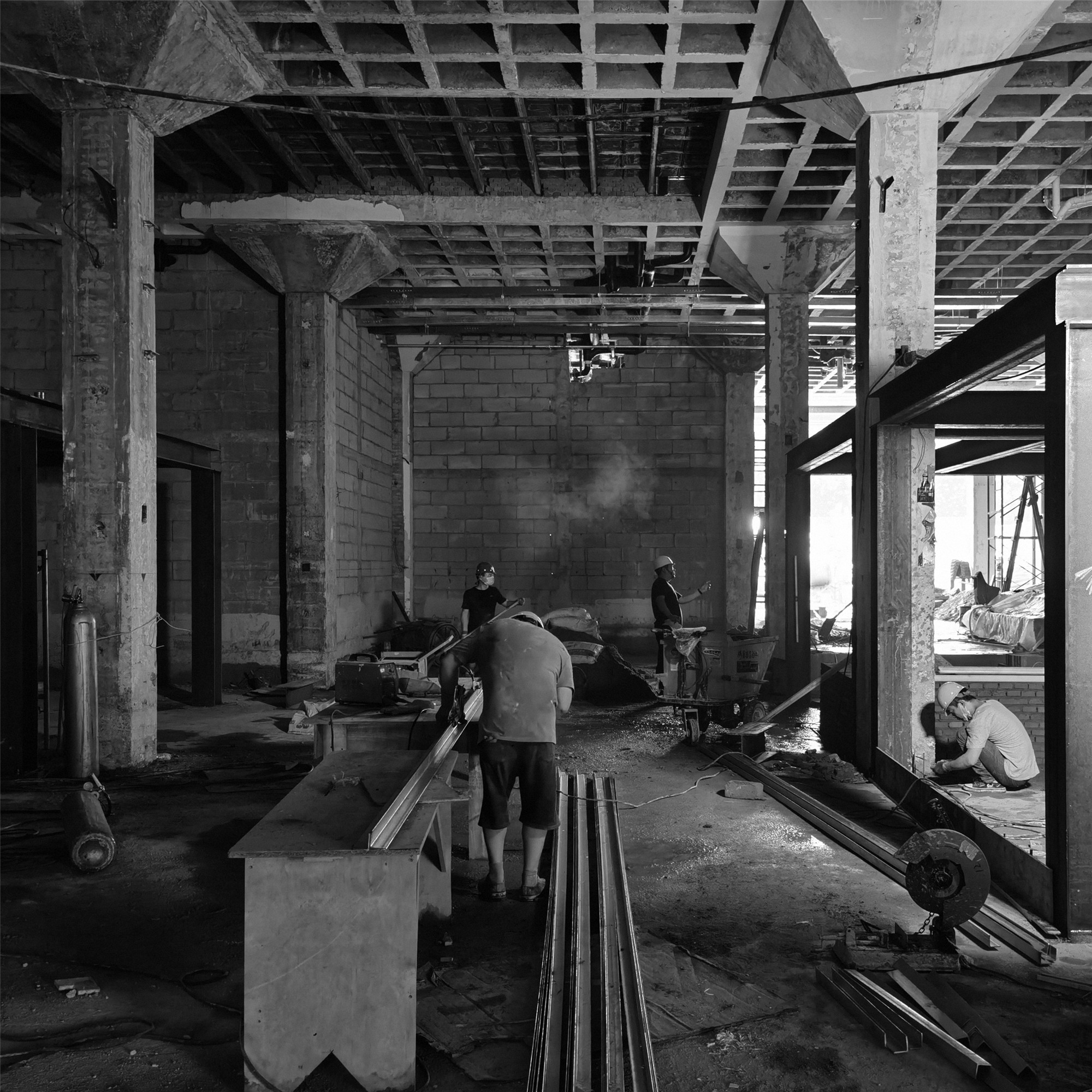
经过40年变迁,建筑空间几经易手,期间用途已不可考。2020年,作为四季民福新址交到我们手中时,城市及设计师对存量建筑的更新改造正在活跃发生。
In the following 40 years, the building has changed hands several times, and its function is no longer known during the period. Until 2020, when the new site of Siji Minfu was handed over to the designer Wu Wei, the renewal and transformation of the existing buildings was actively taking place in the city.
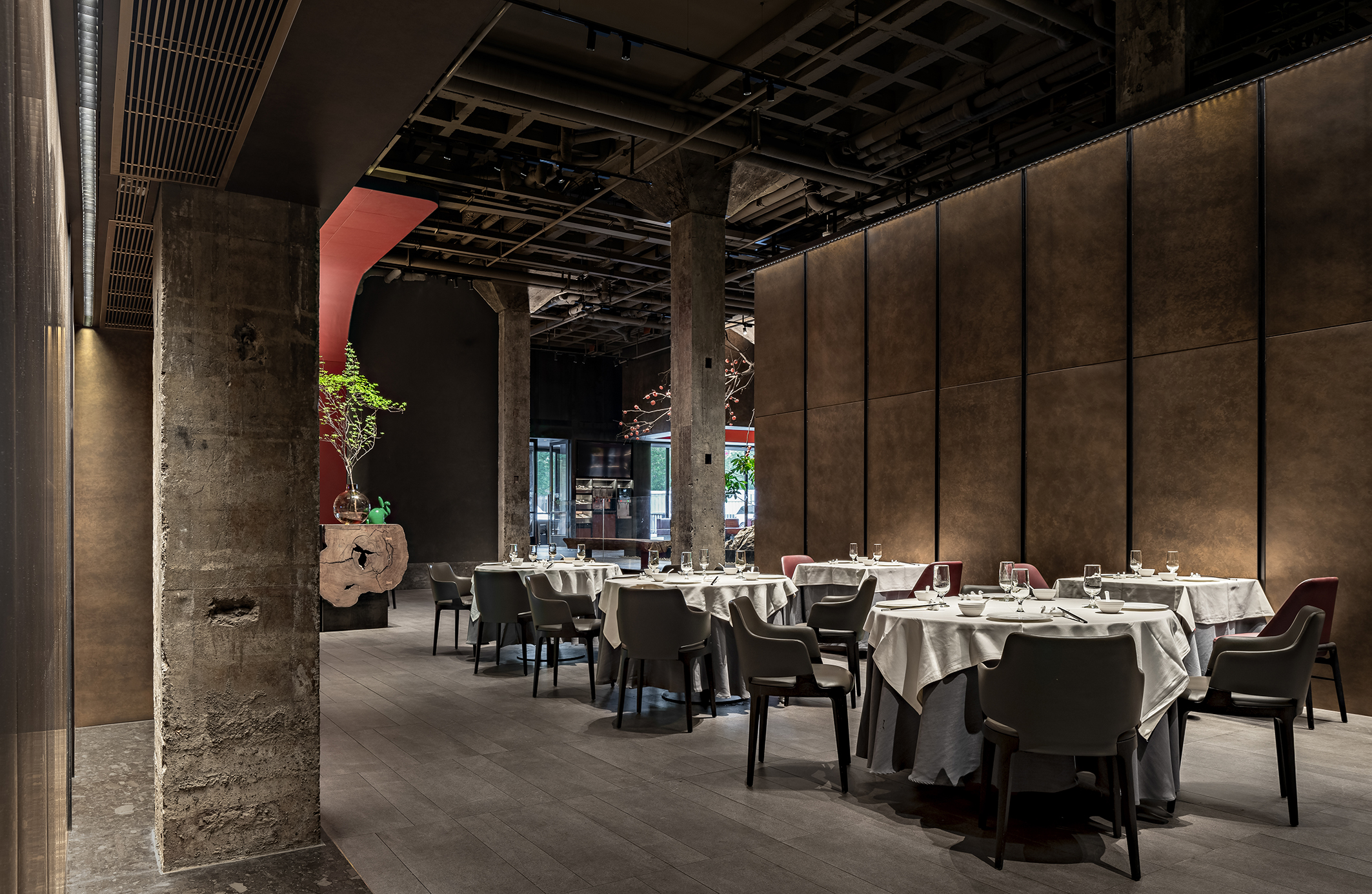
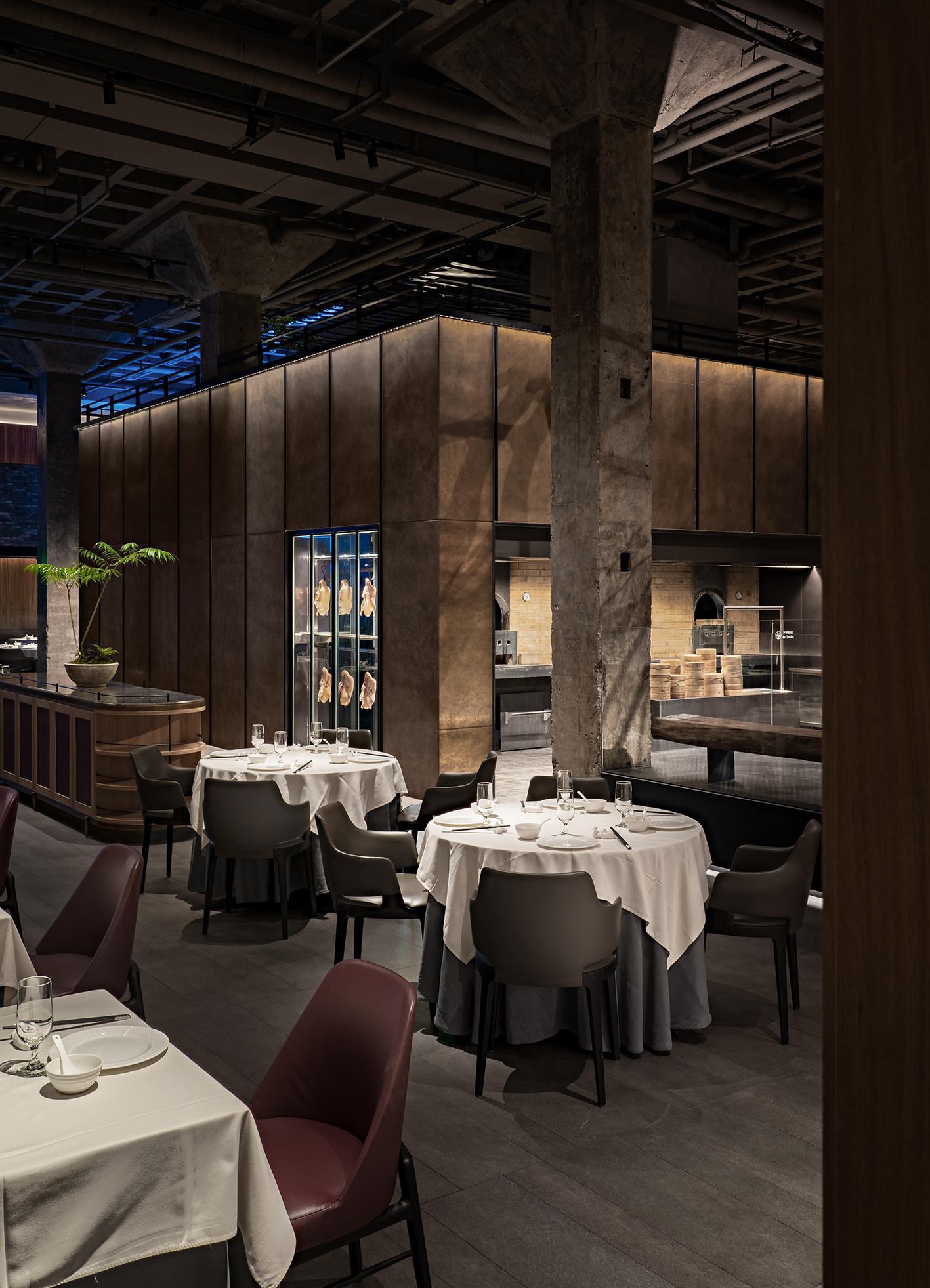
01
守住超级体量
柱网间距为5.6米的35根立柱撑起原建筑的空间,单层净空高度达到5.8米。规整的空间、良好的通风和卫生条件是原建筑的天然优势,巨大的四角柱帽与蜂窝屋面成为建筑内部的强符号特征。与此同时,新餐饮空间对坪效提升的需求也不得不被纳入设计的考量。
The 35 columns with gaps of 5.6 meters support the original building, and the single-story height reaches 5.8 meters. With the advantages of structured space, good ventilation, and sanitary conditions, the original building is featured with a huge four-corner cap and honeycomb roof. At the same time, the demand for improved floor efficiency of the new dining space has to be taken into consideration in the design.


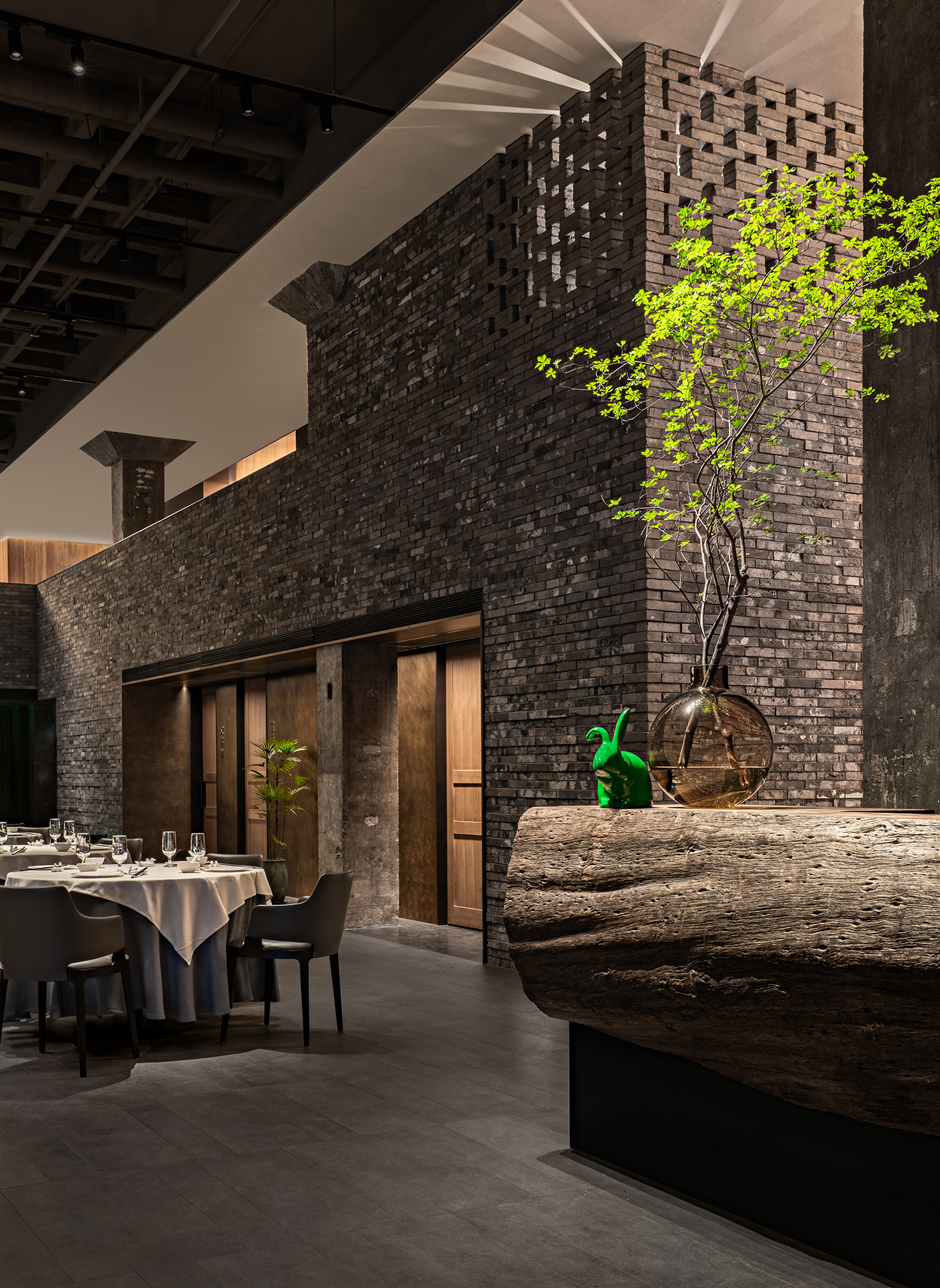
为了留存原建筑对于餐饮空间而言宝贵的“超级体量”和大尺度的恢弘写意,设计师将内部空间拆解为两个互为负形空间的模块——一层开放区与二层F形环绕区,位于二层环绕区下方的空间则分布鸭炉、后厨、包房等闭合功能空间。
To preserve the precious super volume and large scale of the original building, the designer dismantled the interior space into two modules as negative space for each other, including an open area on the first floor and the F-shaped roundabout area on the second floor. Under the roundabout area, it is the closed functional space composed of duck stoves, kitchen, and private rooms.
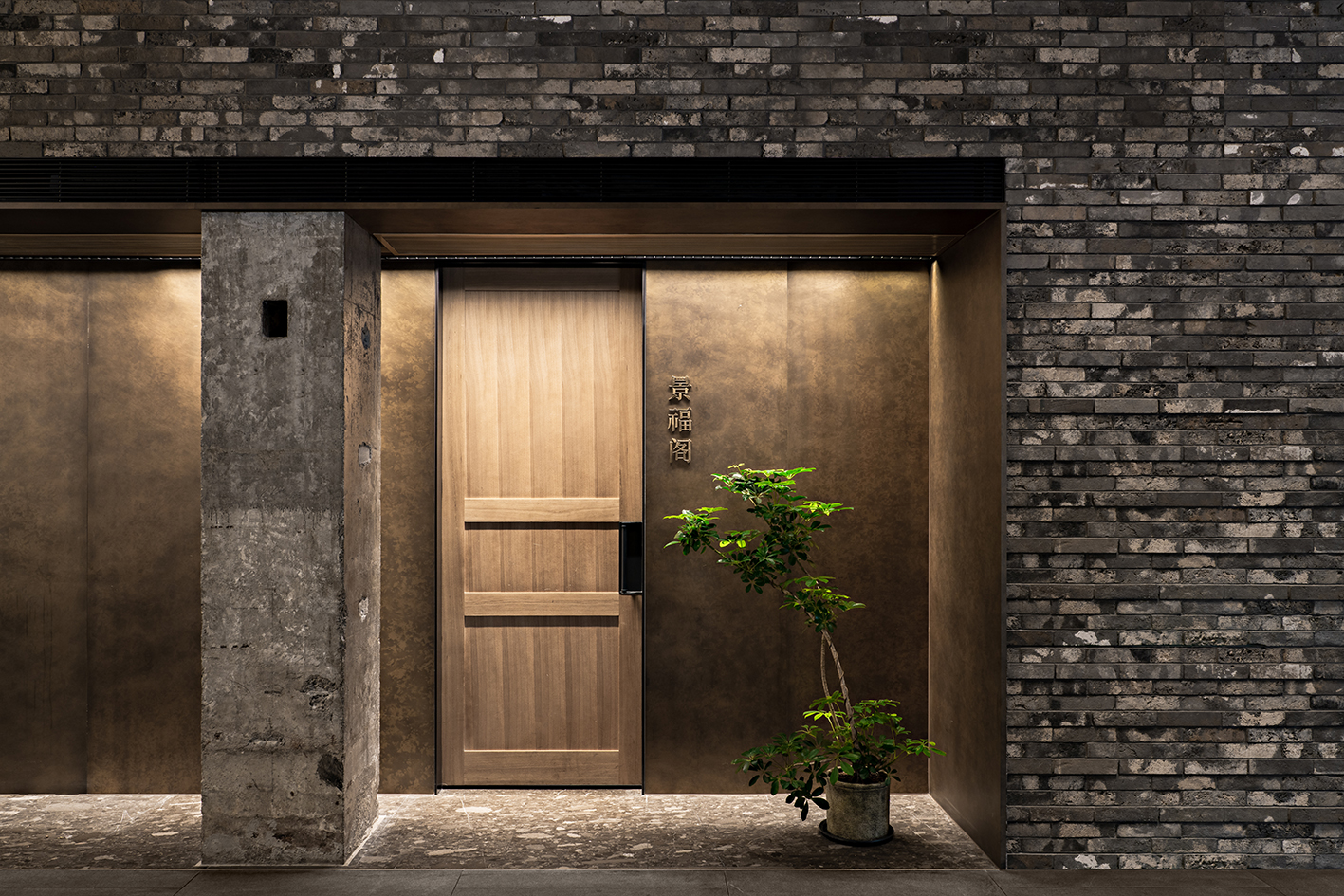
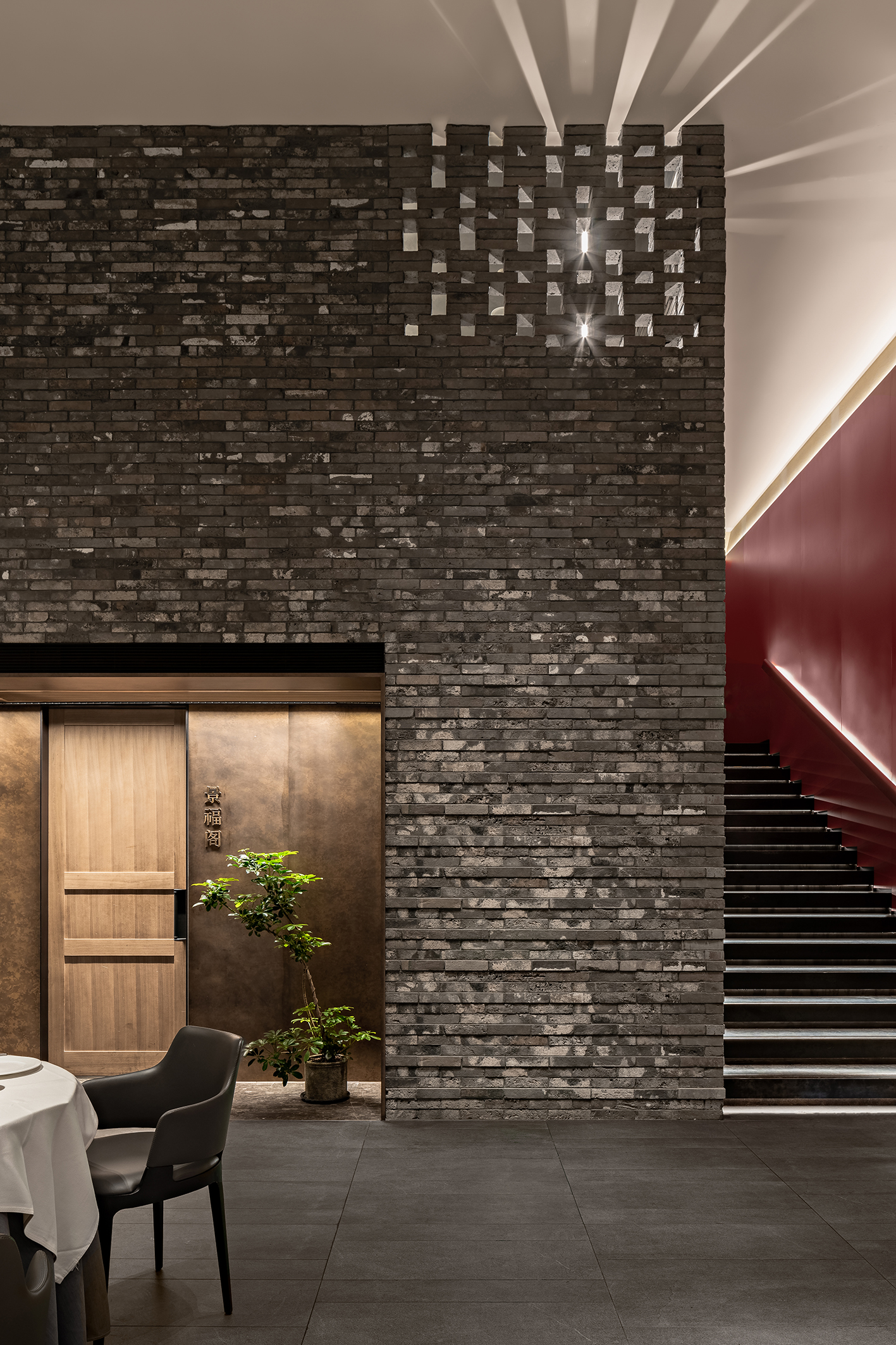

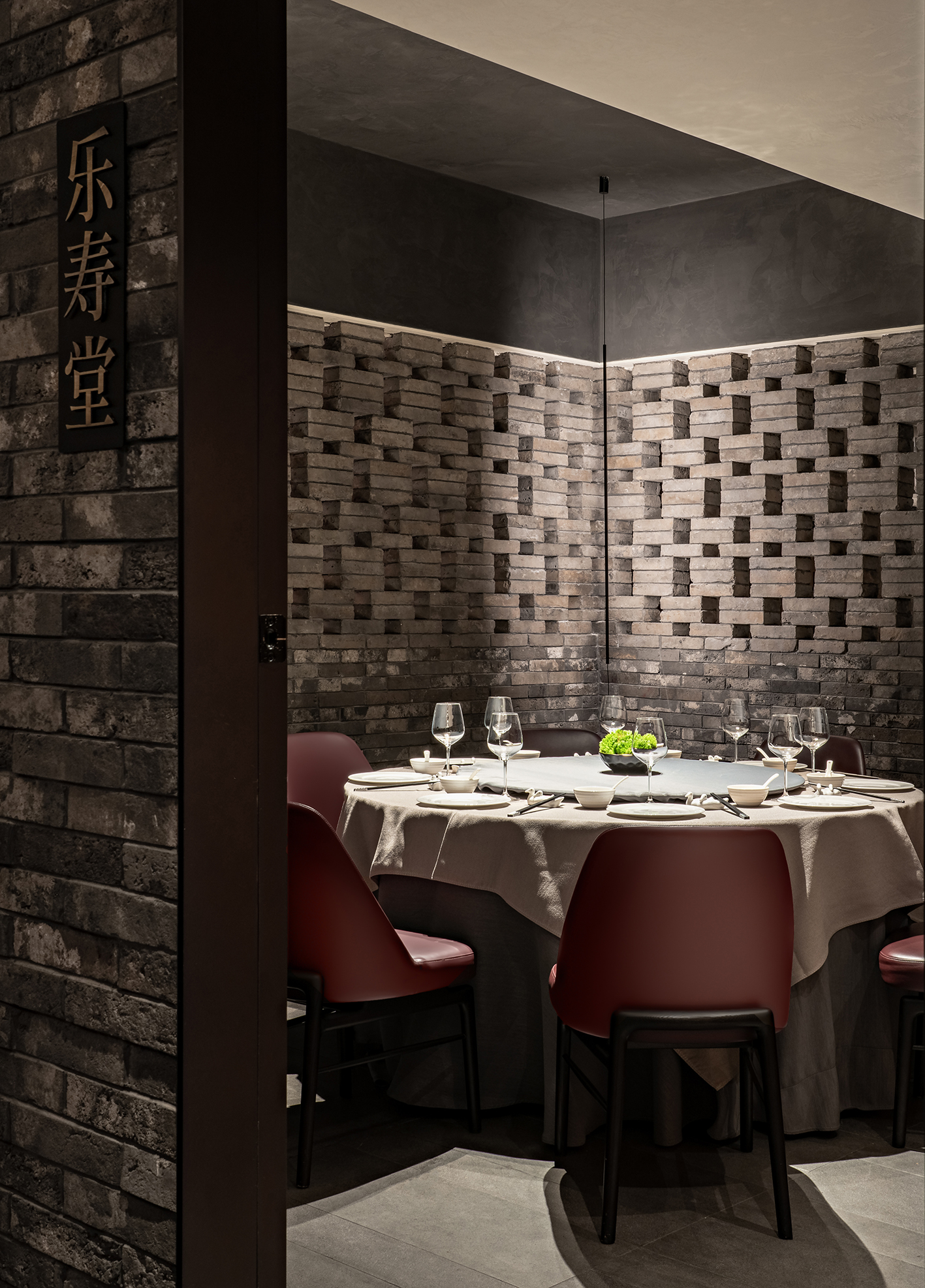
通过东西两处楼梯的连接,空中环游廊道将整个餐厅面貌收入视野,雕塑感强烈的扶梯折线上升,除作为构成动线的功能部件外,也是空间中的视觉焦点。
Through the connection between the east and west stairs, the corridor makes the entire restaurant come into view. When the escalator with strong sculptural sense rises up, it acts as a functional part that constitutes the moving line, and it is also the visual focus of the space.
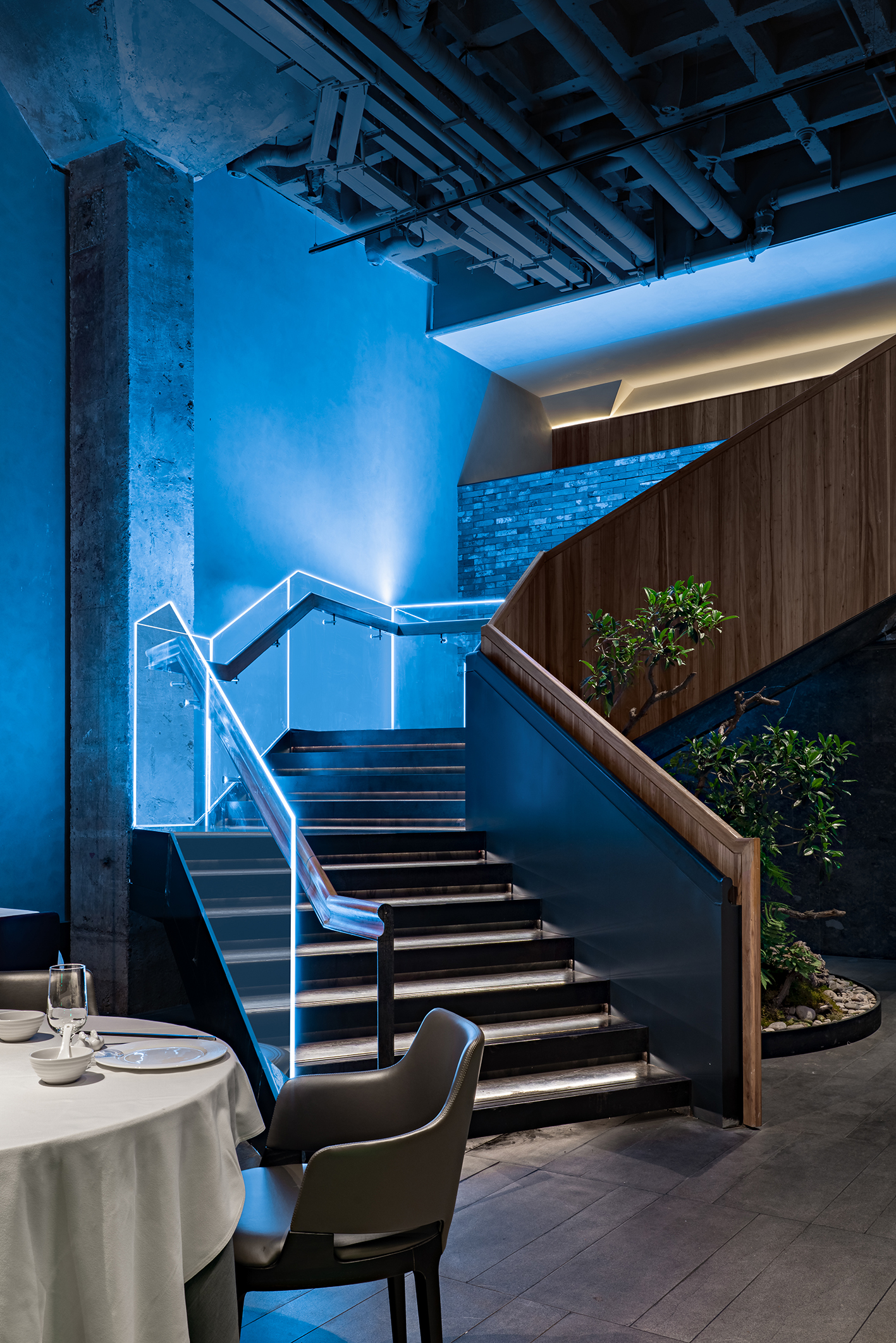
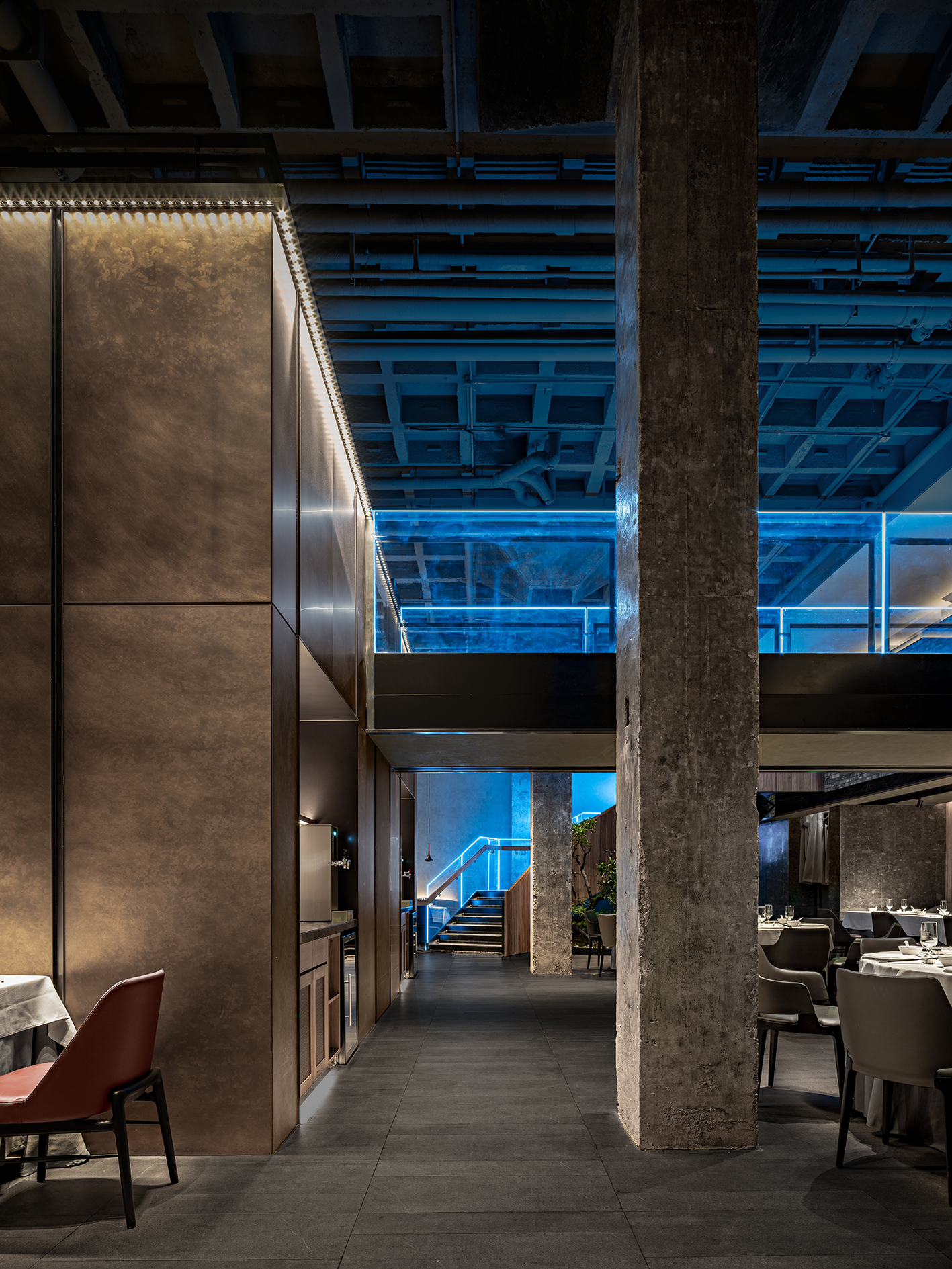
行至首层鸭炉上方的二层“舞台”,360度开放场景使人置身于盛大开阔的“殿宇”——立柱高耸斑驳,“穹顶”向上挑起,立面将新旧材料接续。巨大的空间留白被释放,餐厅体验在这一刻被拉向峰值。
Up to the second-floor stage above the duck stove, the 360-degree open scene puts people in the grand and open "temple", where the columns are tall and mottled, connected with new and old materials. A huge blank space has remained, thus, the experience in the restaurant reaches the best at this moment.


02
场景、时间、人
空间自开阔的等位区而起,从天花垂下的庞然“藻井”结构以热烈的红色打开专属于此处的烟火气,雕塑感的倒挂模块将围合等位区的人情气韵聚拢,镜面则将中央景观二次投射向屋面,在垂直方向拉伸视线,此时此地,甚至能获得优于室外花园的满足体验。
Space starts from the open waiting area, where the huge caisson structure hanging from the ceiling opens up the warm atmosphere exclusive to Siji Minfu through red color. The sculptural upside-down module gathers the diners and popularity. The mirror surface projects the central landscape to the roof, stretching the sight vertically. Here and now, a satisfying experience better than that of an outdoor garden can be achieved.
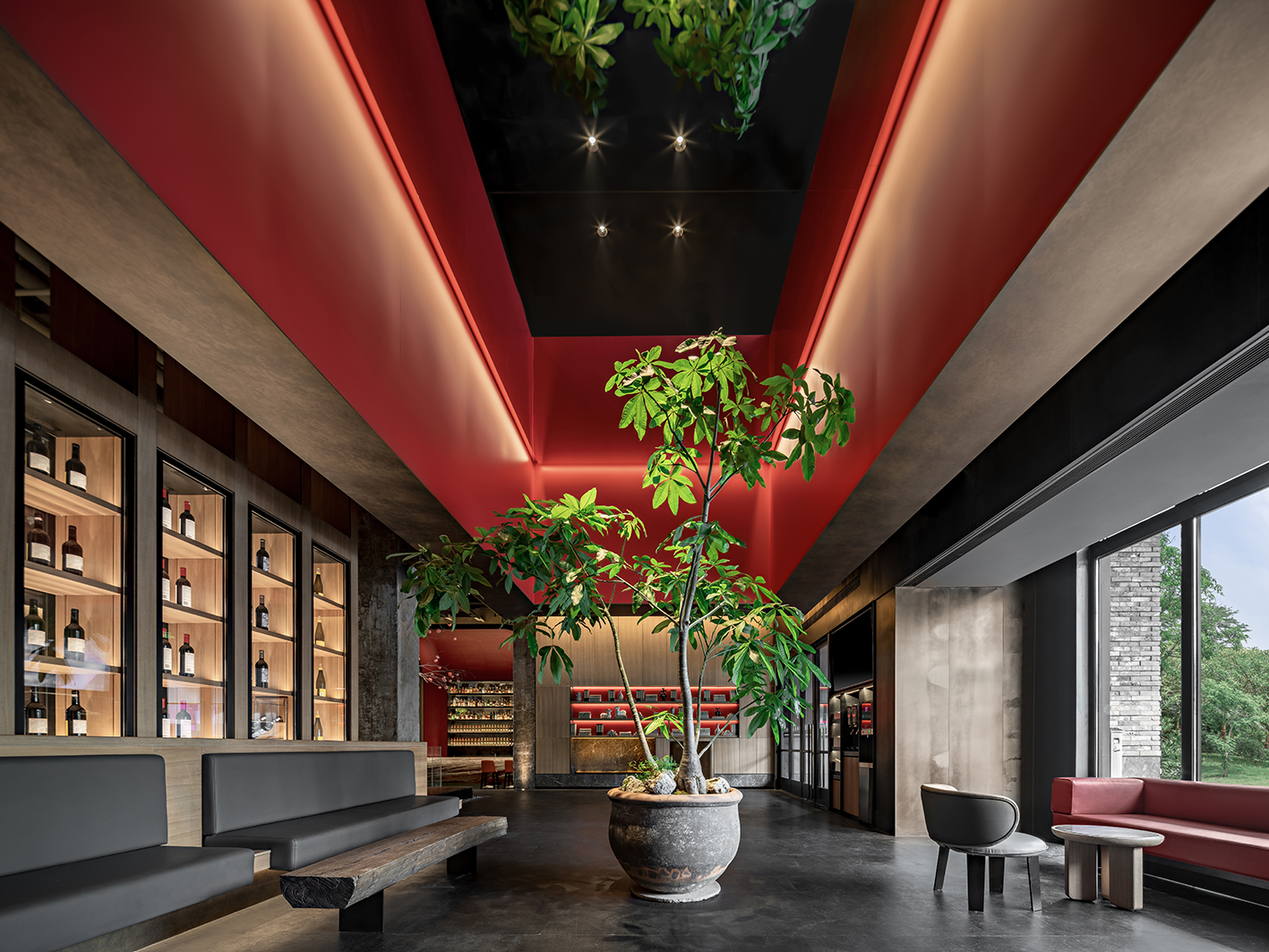
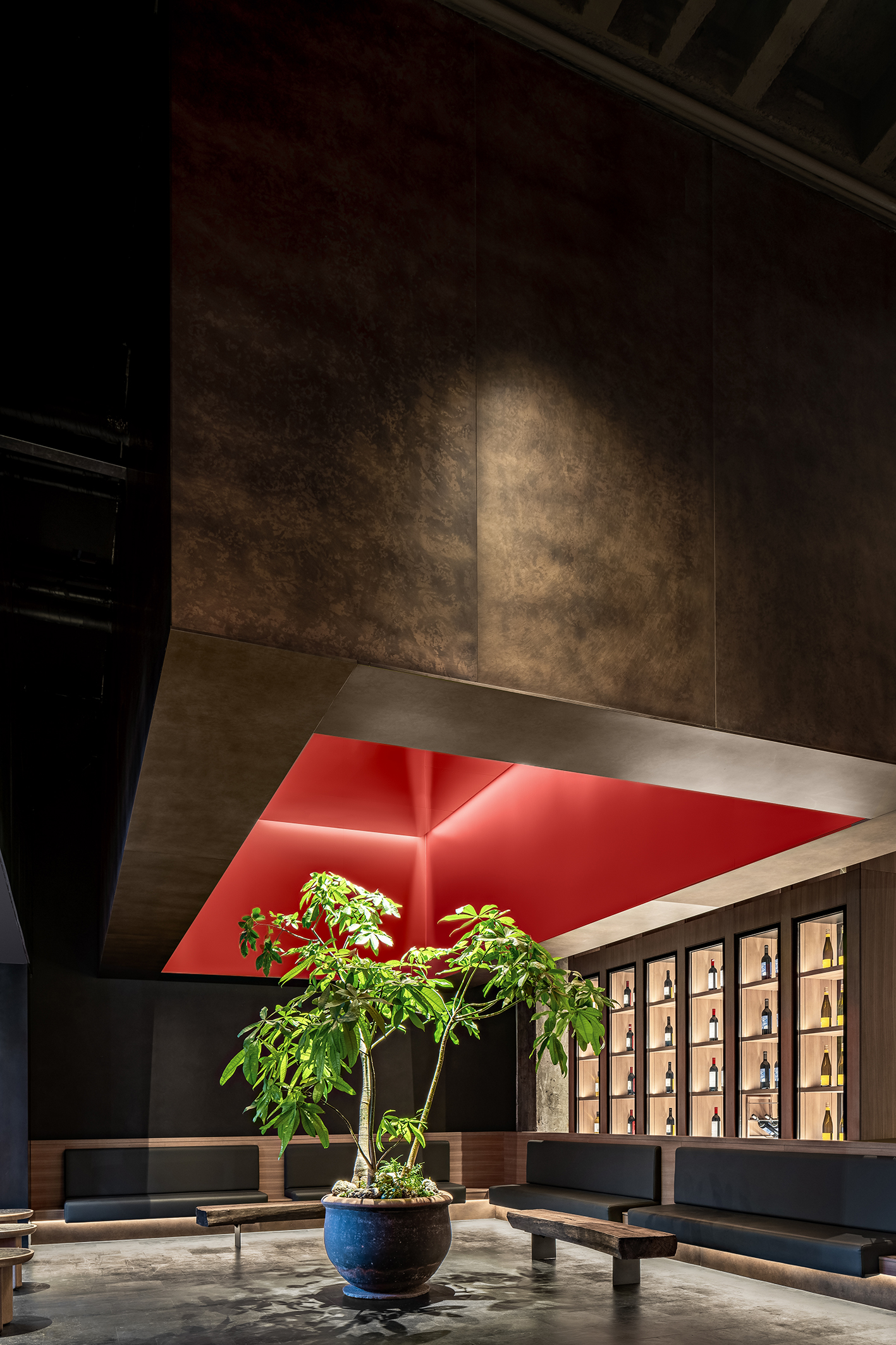
当人们已经习惯了高密度的居住和就餐环境,新空间里独立占据整个区域的水景与山石甚至有点奢侈,我们似乎能重新找回和水相处的乐趣,垂下的柿子树枝条也将记忆倒回童年四合院场景里的一帧。
When people have become accustomed to the high-density living and dining environment, the waterscape and rocks that occupy the entire area independently are even a bit extravagant. In the restaurant, diners can regain the fun of getting along with water, and the hanging branches of persimmons recall the childhood memories of life in the courtyard.
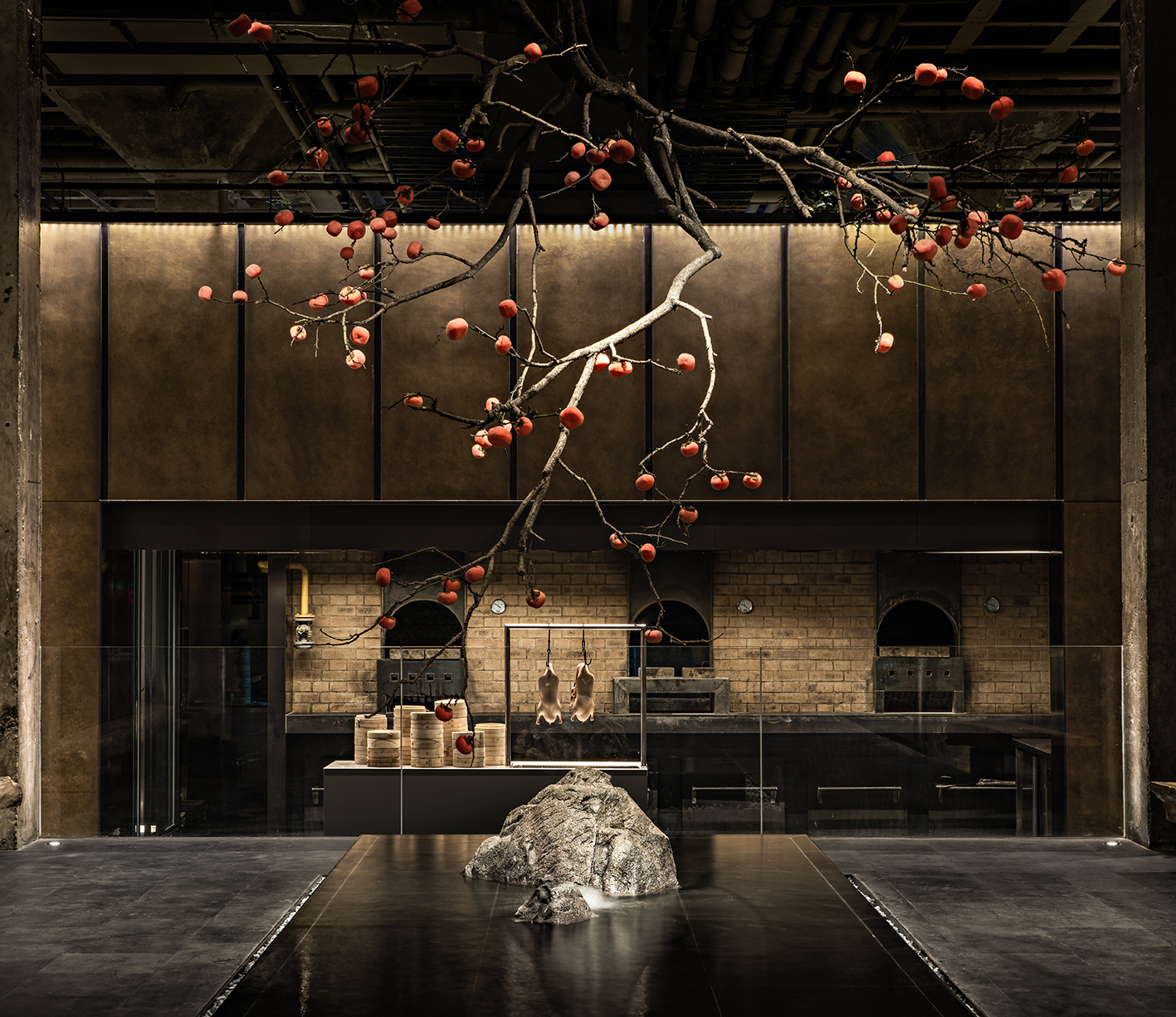
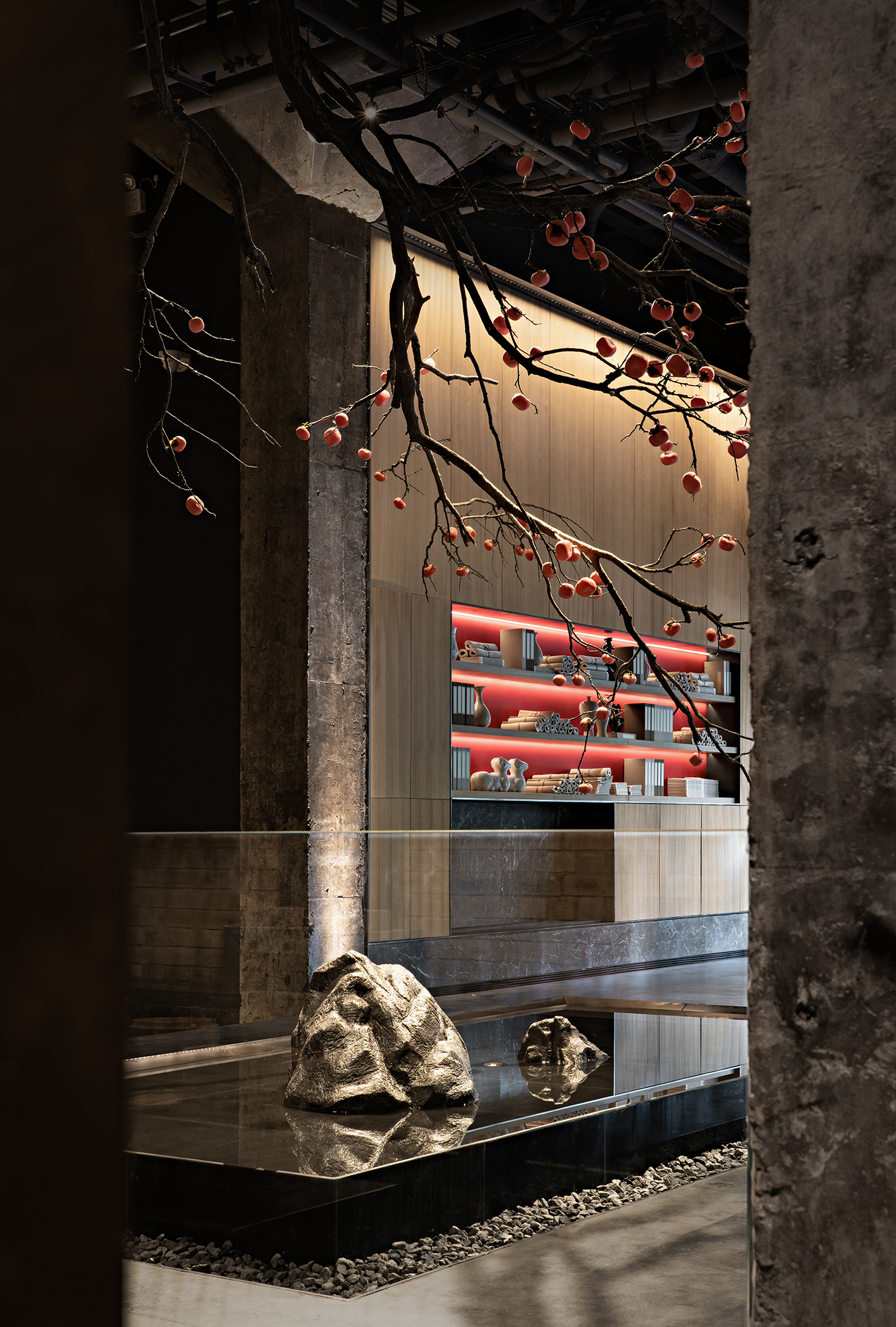
为延续品牌的理念,质地密实、颗粒细腻的故宫金砖、京城民居常见的灰调青砖,与大面积保留的清水泥素面墙体一起构建出空间底色。近乎于宏大的场景里,肃然静默的空间、粗糙温煦的肌理、涌动的水流与日常情愫叠加,平和与气度共存一处。
Continuing the brand concept of Siji Minfu, the dense and fine-grained Forbidden City gold bricks and the gray-toned black bricks of Beijing residential buildings, together with the large-area reserved clear cement plain wall, form the space palette. In the almost grand scene, the solemn and silent space, the rough and gentle texture, the gurgling water, and the daily emotions are superimposed, and peace and grace coexist in the place.


红色吧台区构建出另外一个场景——5.2米高的红色立面向上延伸,弯曲成弧形顶面与并建筑结构相接,形成灰色水泥盒子中的一个嵌套的模块,古老京城似乎正从这一隅慢慢醒来,被注入鲜活涌动的生命力。
The red bar constructs another scene: the 5.2-meter-high red facade extends upwards, curved into a surface, and connects with the building structure to form a nested module in a gray cement box. Waking up slowly, the ancient capital city was injected with surging vitality.
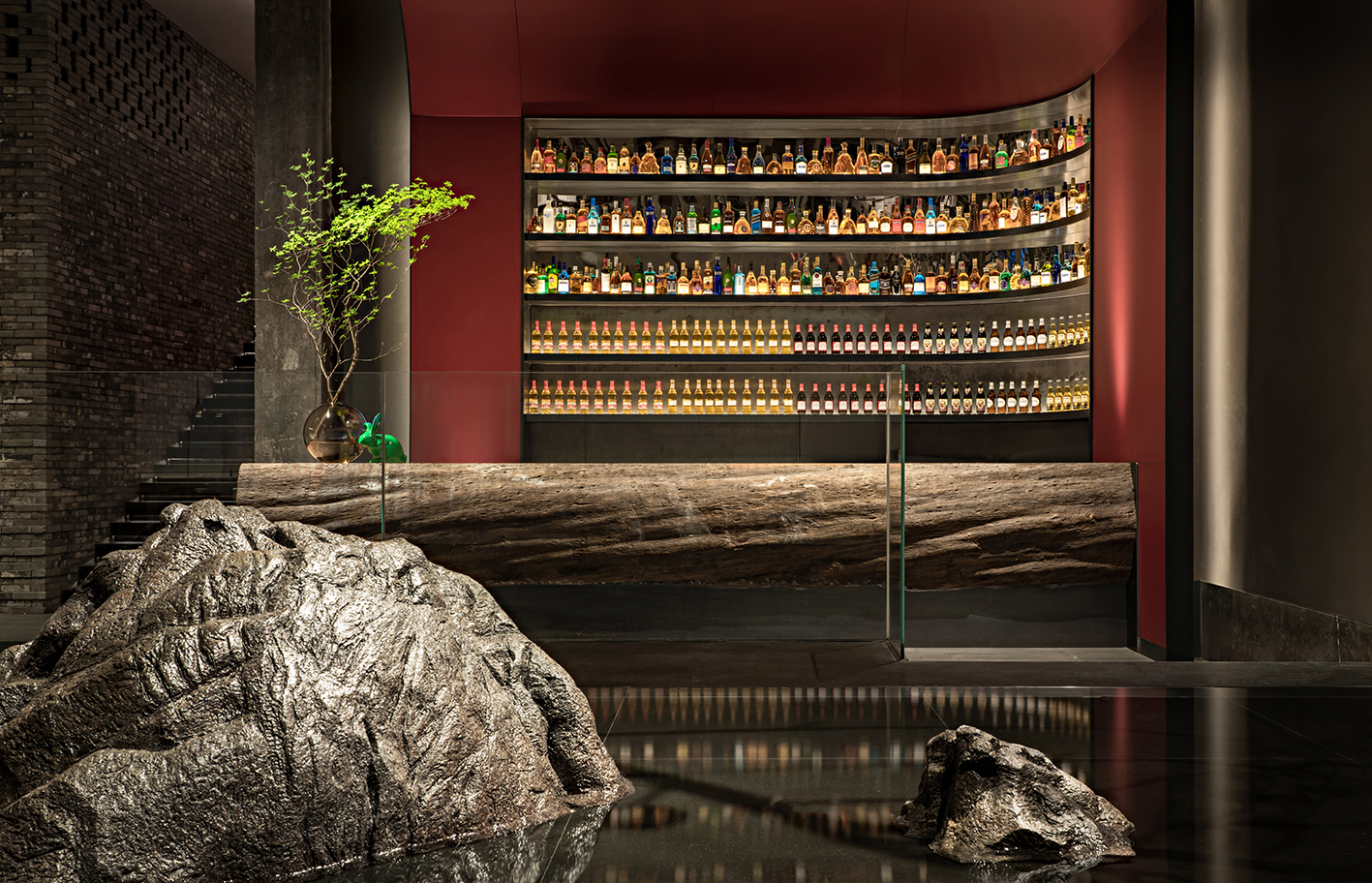
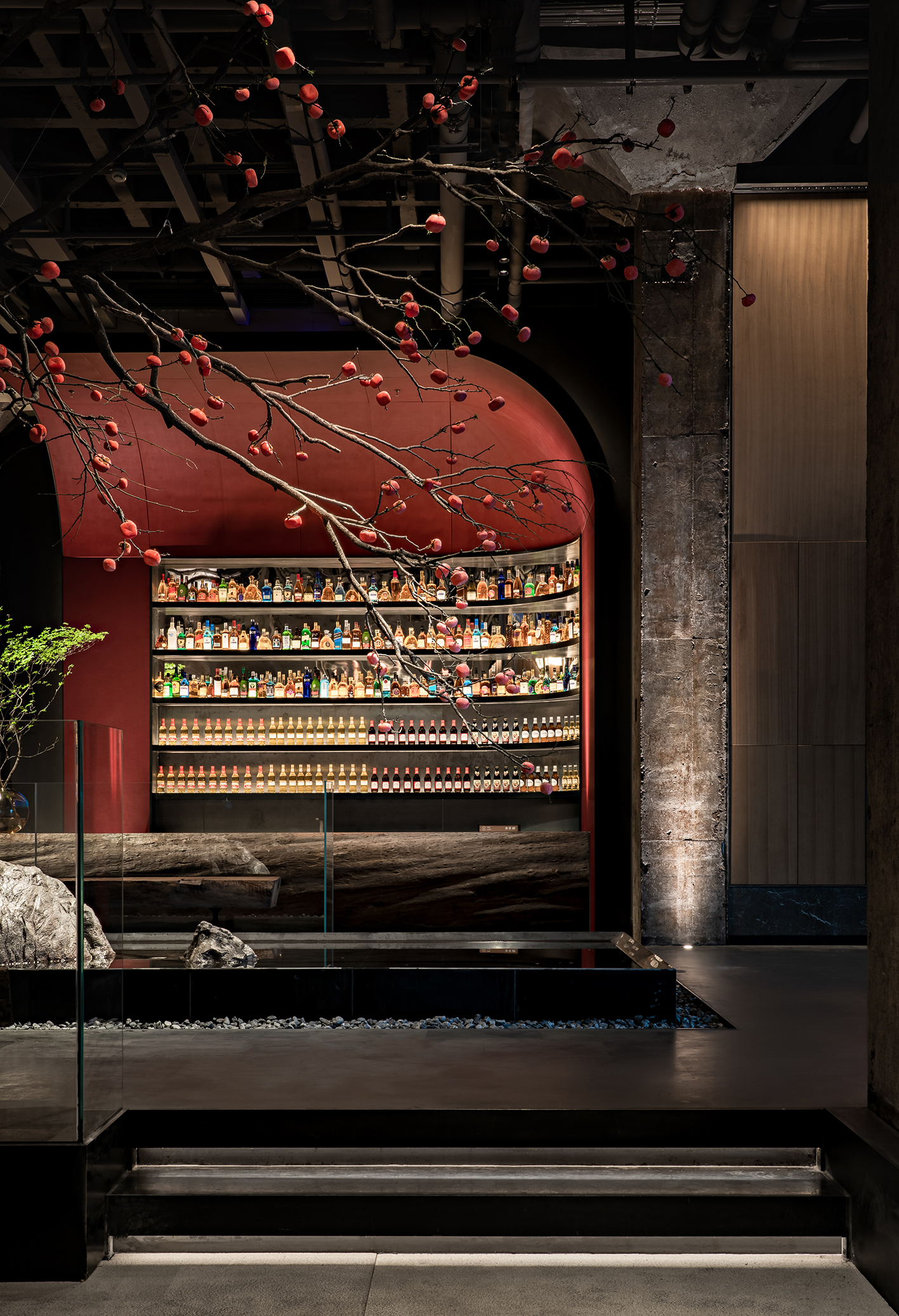


进入晚餐时段,大面积渲染的蓝色灯光从天花及部分墙面“溢出”,如同数字化的夜晚天光。当代设计手法、传统地域文化与旧建筑符号交汇成动态的时间线,与进入空间的每个人发生交互。
At dinner time, large-scale rendered blue lights overflow from the ceiling and part of the walls, like digital night skylight. Contemporary design techniques, traditional regional culture, and old architectural symbols merge into a dynamic timeline that interacts with everyone who enters the space.

03
大众餐饮“再定义”
在道路与住宅密集排布的马连道区域,全新的空间无论作为面向周边人群的新餐饮场所,还是作为接续旧建筑的更新尝试,它都以最节能、最高效的方式在快速更新后提供了现在的诸多可能性。
In the Maliandao area where roads and houses are densely arranged, whether as a new dining place for the surrounding people or as a renewal of the old building, the brand-new space provides many possibilities at present after rapid renewal in the most efficient way.
高速的城市化进程已经让人们习惯于狭小拥挤的餐饮空间,当我们以在“网红店”争得一张小桌为乐时,本案拿出了另外一种可能性,在创造颠覆性的舒适就餐体验的同时,新空间以适度的切入点完成了对老建筑的彻底更新,建筑旧影成为了构建新场所的一部分基因,在迭代中获得“1+1远大于2”的效果。
The rapid urbanization process has made people accustomed to small and crowded dining spaces. When others are striving to get a small table in the "net celebrity shop", Siji Minfu came up with another possibility, creating a remarkably comfortable dining experience, as well as completing the renewal of the old building from a moderate starting point. The old trace of the building has become a part of the gene in the construction of the new place, and the effect of 1 plus 1 is far greater than 2 in the renewal project.
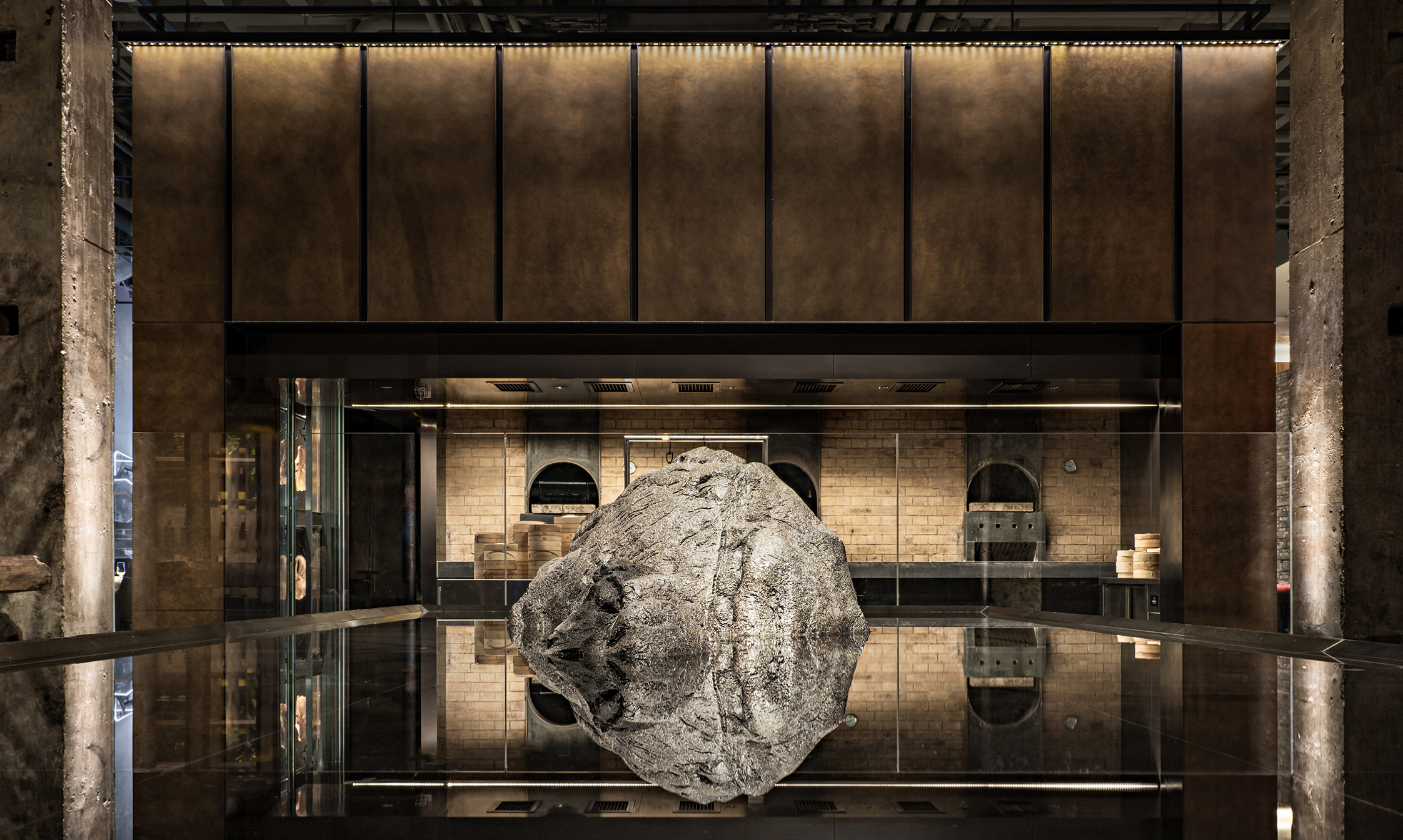
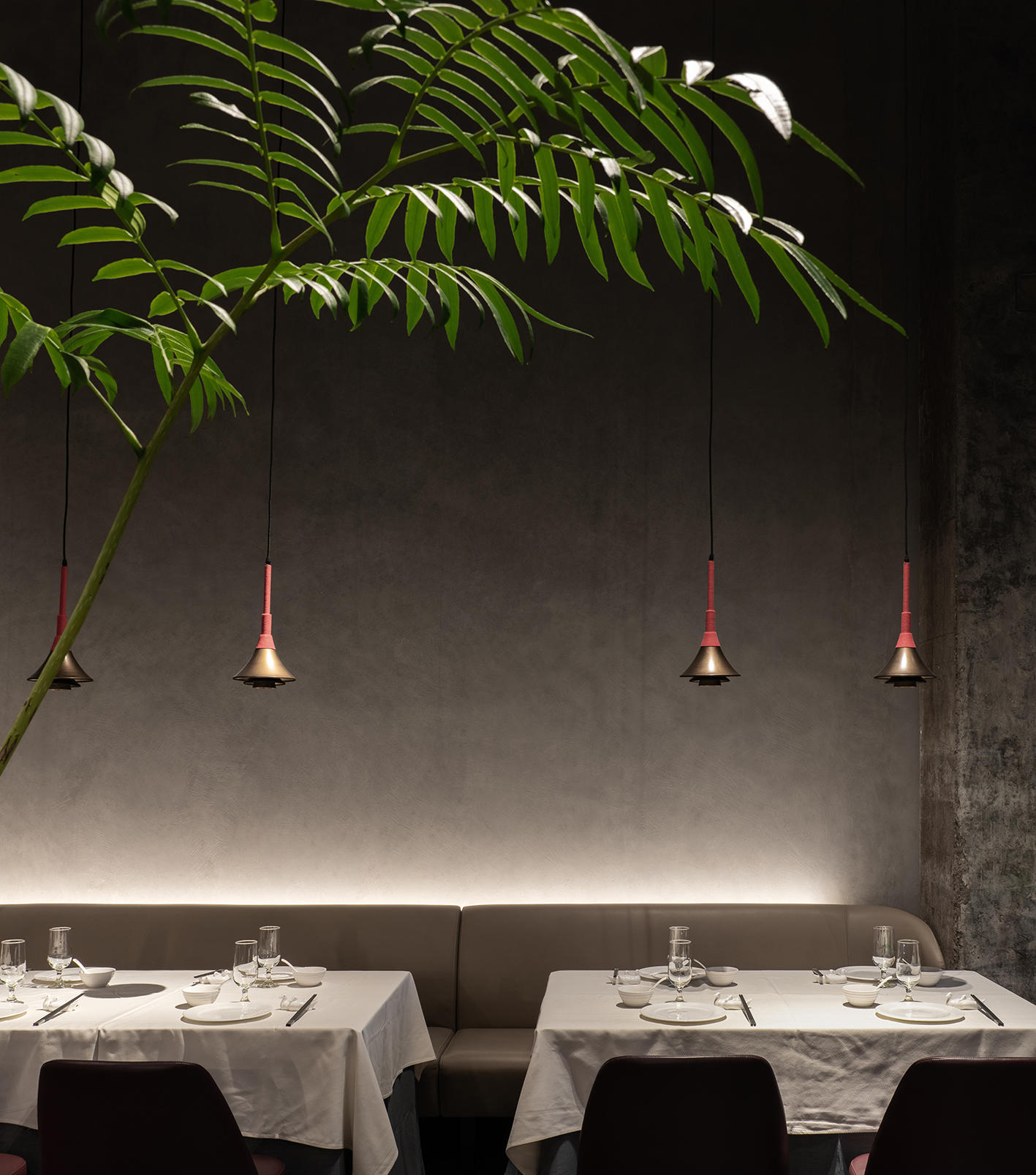
四季民福作为成熟的京城餐饮品牌已经走过了14年,面对年轻化程度越来越高的客群和不断多元化的餐饮需求,走出曾经的“安全地带”势在必行,设计团队以不断升级的品牌形象重新建立食客的认知与粘性,同新的餐饮、社交、城市需求更紧密地连结,也让四季民福为大众餐饮的“再定义”迈出探索的一步。
As a mature catering brand in Beijing for 14 years, Siji Minfu is facing an increasingly younger customer group and diversified catering needs, it is imperative to step out of the safe zone. IN.X adopts the strategic catering design method to re-establish the recognition and stickiness of diners through the constantly upgraded brand image. Closely connected with the new catering, social and urban needs, Siji Minfu is moving towards and exploring the redefinition of public catering.
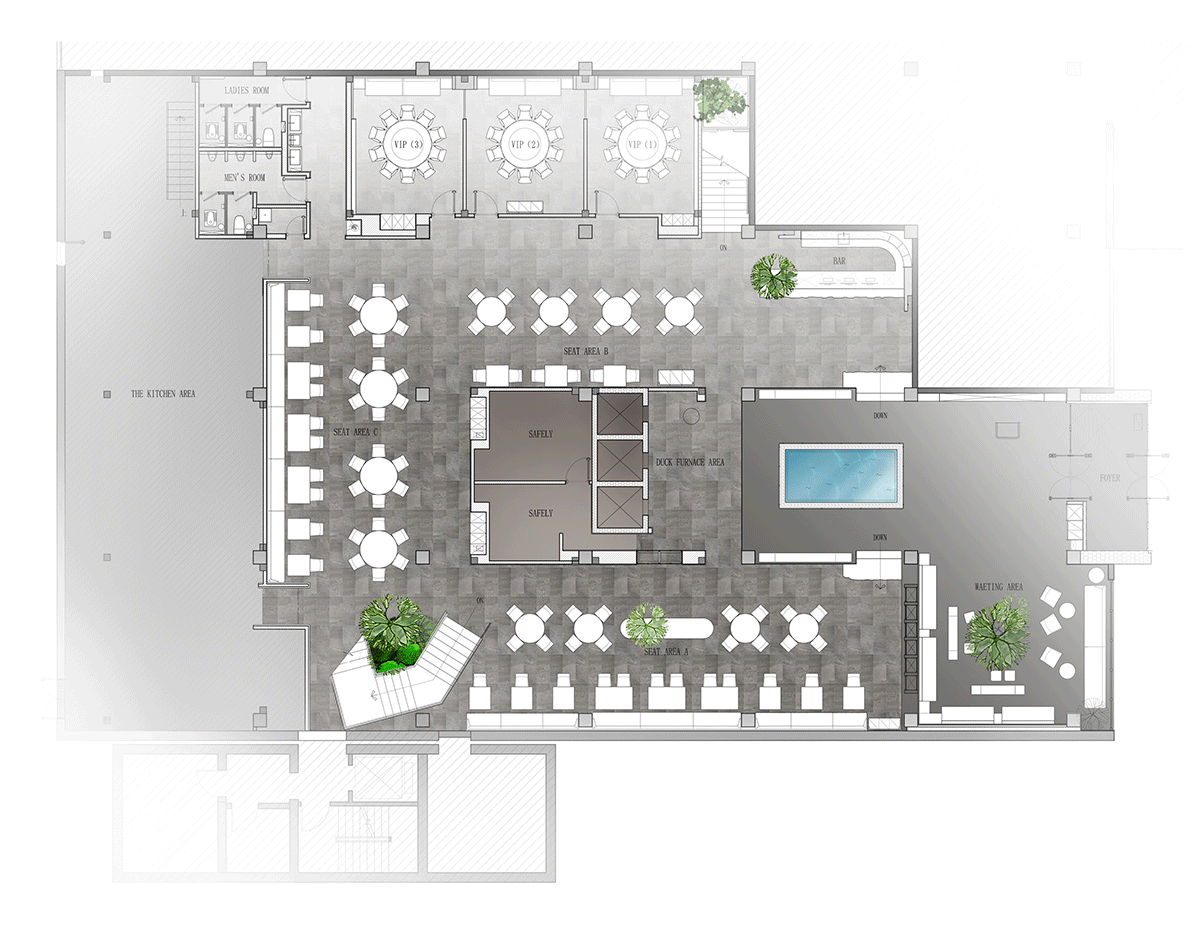
完整项目信息
项目名称:四季民福马连道店
项目地点:中国北京
项目面积:1260平方米
建成时间:2020年11月
室内设计:IN.X屋里门外设计
设计主创:吴为
设计团队:刘晨阳、贾琦峰、李岩
室内陈设:宋江丽、金升旭、应哲光
灯光设计:朱海燕
项目摄影:郑焰
项目策划:楽品牌策略机构
版权声明:本文由IN.X屋里门外设计授权发布。欢迎转发,禁止以有方编辑版本转载。
投稿邮箱:media@archiposition.com
上一篇:浙江大学艺术与考古博物馆:立面上的“编织” / Gluckman Tang Architects
下一篇:建筑地图131 | 苏州:绝妙的江南